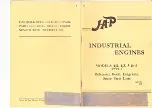
MAN048 ING
33
Sprocket
ratio
Teeth n° Engine sprocket
Sprocket
ratio
Teeht n° Engine sprocket
Teeth n°
axle sprocket
10
11
Teeth n°
axle sprocket
10
11
72
7,20
6,55
83
8,30
7,55
73
7,30
6,64
84
8,40
7,64
74
7,40
6,73
85
8,50
7,73
75
7,50
6,82
86
8,60
7,82
76
7,60
6,91
87
8,70
7,91
77
7,70
7,00
88
8,80
8,00
78
7,80
7,09
89
8,90
8,09
79
7,90
7,18
90
9,00
8,18
80
8,00
7,27
91
9,10
8,27
81
8,10
7,36
92
9,20
8,36
82
8,20
7,45
For the operation limit of 16500 RPM the following table (Tab.2) has been prepared.
SUGGESTION:
§
During the track tests we recommend use of a tachometer recording the max
obtained engine RPM.
§
Use sparkplug caps with a resistance of 5KΩ to avoid eventual interferences
between the engine ignition and the tachometer and/or telemetry.
The following example should clarify the procedure for the optimization of the sprocket.
Assume to use the engine with Z=10 teeth engine sprocket and that during the
preliminary track tests a Z=72 teeth axle sprocket has been used.
§
From table 1 with Z=10 as engine sprocket and Z=72 on the axle sprocket, a ratio of
7.20 is found.
§
Make a few laps on the track and, let us assume that you read 14.000 max engine
RPM.
§
From the table 2 to achieve a max RPM of 16500 RPM (operating limit for the Leopard
engine) a sprocket ratio from 8.37 and 8.60 should be used (having used, during the
tests, a sprocket ratio of 7.2 and having achieved 14.000 RPM max.).
§
From table.1, with these values, a sprocket ratio of 10:84 / 10:86 should be used or,
having a Z=11 on the engine sprocket, a ratio 11:92 should be used.
Tab.1
Summary of Contents for Parilla Leopard TaG Series
Page 46: ...MAN 048 ING 44...












































